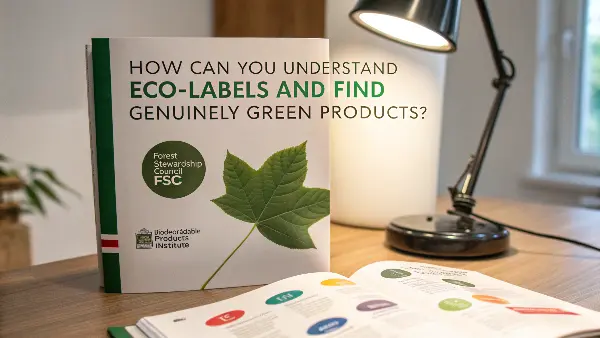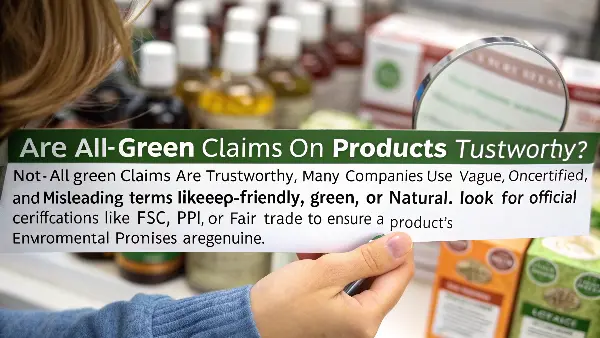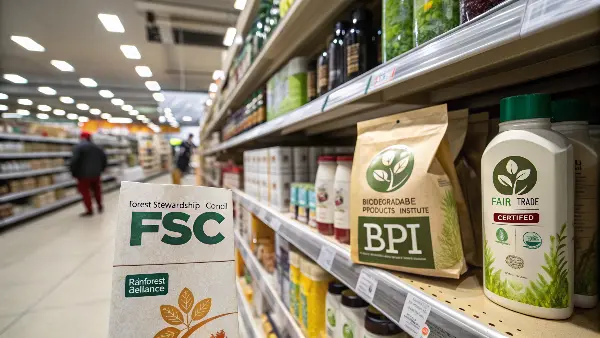Are you overwhelmed by all the green symbols and claims on product packaging? It feels impossible to know which ones are legitimate and which are just clever marketing. This guide will help you decode the most common eco-labels so you can confidently choose products that are truly better for our planet.
To understand eco-labels, you need to recognize official certifications that verify a product’s environmental claims. Look for symbols from trusted third-party organizations like the Forest Stewardship Council (FSC) for paper or the Biodegradable Products Institute (BPI) for compostable items. These labels are based on rigorous standards, unlike vague terms like "eco-friendly" or "natural." By learning to spot these key certifications, you can confidently distinguish genuinely green products from those using misleading marketing.

I’ve been working in sustainable sourcing for over a decade, and even I find the sea of green logos confusing at times. But once you know what to look for, the fog clears and making the right choice becomes much easier. Let’s break down what these labels really mean and how they can guide your purchasing decisions. It’s time to gain that clarity and feel good about the products you and your business choose.
What Exactly Are Eco-Labels and Why Do They Matter?
You see "green" stickers and logos everywhere these days, but what do they truly represent? Without knowing their meaning, you risk accidentally supporting companies that aren’t genuinely committed to sustainability. Let’s define what a real eco-label is and explain why it’s a critical tool for making responsible choices for our planet.
Eco-labels are official marks or certifications placed on product packaging to confirm that they meet specific environmental or social standards. They matter because they provide credible, third-party verification of a company’s green claims. Instead of relying on vague marketing terms, these labels offer proof that a product has a reduced environmental footprint, is sourced responsibly, or meets specific end-of-life requirements. They are a trusted shortcut for making genuinely sustainable decisions.

The world of eco-friendly products can feel like the Wild West. Any company can print a green leaf on its packaging and call it a day. That’s where official eco-labels come in. They are designed to bring order to the chaos and give you, the buyer, a reliable tool. I remember a time when our company was looking for a new supplier of paper cups. One company had a beautiful logo of a planet on their samples, but no official certification. Another had a simple, less flashy FSC logo. The first company’s claims were just words; the second company’s claim was backed by a global standard.
The Power of Third-Party Verification
The most important feature of a trustworthy eco-label is that it is awarded by an independent, third-party organization. This is crucial because it removes bias. The company selling the product isn’t the one deciding if it’s "green." Instead, an organization with no financial stake in the sale audits the product against a strict set of public criteria. This process ensures the claim has integrity. It’s the difference between a student grading their own test and having a teacher do it. One is a guess; the other is a verified result.
What Do Eco-Labels Actually Cover?
Eco-labels are not one-size-fits-all. They cover a wide range of environmental impacts across a product’s lifecycle. Here’s a breakdown of what different labels might certify:
| Certification Area | What It Certifies | Examples |
|---|---|---|
| Sourcing | The raw materials were harvested sustainably (e.g., from a responsibly managed forest). | FSC, Rainforest Alliance |
| Production Process | The manufacturing process used less energy, water, or produced fewer harmful chemicals. | EU Ecolabel, Green Seal |
| Product Content | The product is made from recycled materials or is free from specific toxic substances. | Recycled Content, OEKO-TEX |
| End-of-Life | The product can be safely composted, biodegraded, or recycled after use. | BPI Certified, TÜV AUSTRIA |
This variety means you can look for labels that align with your specific sustainability goals, whether that’s protecting forests, reducing waste, or eliminating toxins.
Are All ‘Green’ Claims on Products Trustworthy?
You find a product proudly labeled "Earth-Friendly" or "All-Natural." It sounds perfect, but a part of you feels skeptical. You worry that you might be falling for "greenwashing"—deceptive marketing designed to make a product seem more sustainable than it is. This tactic can mislead consumers and hurt the credibility of genuinely eco-conscious brands.
No, not all green claims are trustworthy. Many companies use vague, uncertified, and misleading terms like "eco-friendly," "green," or "natural" to appeal to environmentally conscious buyers. This practice, known as greenwashing, lacks the backing of a reputable third-party certification. Truly trustworthy claims are specific, verifiable, and supported by recognized eco-labels like FSC, BPI, or Fair Trade. Always look for an official certification mark to validate a product’s environmental promises.

I once worked with a client who was excited about a line of "biodegradable" plastic bags they had sourced. The packaging had pictures of flowers and trees, reinforcing the green message. However, when we investigated, there was no certification. The supplier simply claimed the bags would break down "over time." We later found out that "over time" meant centuries in a landfill, and they would leave microplastics behind. This experience taught me a hard lesson: marketing is not proof. We immediately switched to a supplier whose bags were BPI Certified Compostable, ensuring they would break down safely in a commercial facility.
How to Spot Greenwashing
Greenwashing preys on good intentions. Companies know that shoppers want to make better choices, so they use language that sounds environmentally responsible without making any real commitments. Recognizing the signs is the first step to avoiding it.
Common Greenwashing Tactics:
- Vague & Fluffy Language: Look out for words that have no clear, legally defined meaning. Terms like "environmentally friendly," "non-toxic," and "green" are classic red flags if they stand alone without any certification to back them up. They sound good but offer zero proof.
- Irrelevant Claims: Sometimes a company will highlight a true but irrelevant fact. For example, a spray bottle labeled "CFC-Free" is meaningless because CFCs have been banned by law for decades. While true, it’s a misleading attempt to look environmentally proactive.
- Hidden Trade-Offs: A product might be advertised as "made from recycled paper," but the company might not mention the chlorine-bleaching process used, which pollutes waterways. Greenwashing often spotlights one small green attribute while ignoring other, more significant environmental harms.
The Importance of Specificity
Instead of falling for broad claims, train yourself to look for specifics. A genuinely sustainable product will have clear, measurable attributes backed by data or certification. For example, instead of just "recycled content," a trustworthy product will state "Made with 80% Post-Consumer Recycled Content." Instead of a generic "compostable," it will carry the BPI or TÜV AUSTRIA certification logo. These specific details show that the company has done the work to verify its claims, moving beyond empty marketing and into transparent accountability.
Which Key Eco-Labels Should You Look For on Packaging?
You’re standing in an aisle, comparing two similar products. You want to choose the more sustainable option, but you’re not sure which logos are meaningful. It’s frustrating when you’re trying to do the right thing but lack the information to make a confident choice. Let’s fix that by highlighting the essential labels you should know.
To make informed choices, focus on globally recognized, third-party eco-labels. For paper and wood products, look for the Forest Stewardship Council (FSC) logo. For compostable food service items, seek out BPI (Biodegradable Products Institute) in North America or TÜV AUSTRIA (OK compost) in Europe. For fair labor practices and sustainability in agriculture, the Fair Trade Certified and Rainforest Alliance seals are key indicators. These labels verify specific, high-level standards.

As a professional buyer, my job is to cut through the noise and find products that meet strict environmental criteria. I can’t just take a supplier’s word for it; I need proof. That’s why I’ve built a mental checklist of key certifications. When I’m evaluating a new line of kraft paper containers or PLA cutlery, the first thing I do is look for these logos. If they’re missing, it’s an immediate red flag and prompts a deeper investigation. These labels are my non-negotiables because they represent a commitment to standards that my company—and our customers—value.
Your Go-To Guide for Major Eco-Labels
Think of these certifications as your trusted allies in sustainable sourcing. Learning to recognize them will empower you to make better decisions quickly and effectively.
For Paper and Wood Products
- Forest Stewardship Council (FSC): This is the gold standard for responsible forestry. When you see the FSC logo, it means the wood, paper, or other forest-based material in the product comes from forests that are managed to meet the social, economic, and ecological needs of present and future generations. There are three types: FSC 100% (from FSC-certified forests), FSC Recycled, and FSC Mix (a combination of the two). For our business, sourcing FSC-certified packaging is fundamental to our commitment to preventing deforestation.
For Compostable Products
- Biodegradable Products Institute (BPI) Certified: This is the leading authority on compostability in North America. The BPI logo certifies that a product has been tested by an independent lab and will break down safely in a commercial composting facility within a specific timeframe, leaving no toxic residue behind. This is crucial for items like PLA cups, bagasse containers, and compostable cutlery.
- TÜV AUSTRIA (OK compost HOME/INDUSTRIAL): This is a key certification body in Europe and globally. They offer several marks, with "OK compost INDUSTRIAL" being similar to BPI’s standard. They also offer an "OK compost HOME" certification, which is even stricter, verifying that a product can be composted in a backyard compost pile.
For Social and Agricultural Responsibility
- Fair Trade Certified™: This label focuses on the human side of sustainability. It ensures that farmers and workers in developing countries receive fair wages, work in safe conditions, and can invest in their communities. You’ll often see it on products like coffee, chocolate, and cotton.
- Rainforest Alliance Certified: The little green frog seal signifies that a farm, forest, or tourism enterprise has been audited to meet rigorous standards that protect wildlife, forests, and the well-being of workers and local communities.
What’s the Difference Between a ‘Compostable’ and ‘Biodegradable’ Label?
You’ve probably seen the terms "biodegradable" and "compostable" used a lot, sometimes even together. It’s easy to assume they mean the same thing, but this confusion can lead to well-intentioned items ending up in the wrong place, like a landfill. Understanding the key differences is essential for proper disposal and a truly circular economy.
"Compostable" is a specific, certified claim, while "biodegradable" is a vague and often misleading term. A certified compostable product (e.g., BPI Certified) is guaranteed to break down into natural elements in a commercial composting facility within about 90-180 days. "Biodegradable" simply means something will break down over time, but that could take hundreds of years in a landfill and potentially leave behind toxic microplastics. Always choose certified compostable over a generic biodegradable claim.

This distinction is one of the most critical I teach to new team members and clients. A few years ago, we audited a food festival that proudly used "biodegradable" forks. After the event, they sent all the food waste and forks to a local composting facility. A month later, the facility called to complain. The forks were still perfectly intact, contaminating their entire batch of compost. The festival organizers had been greenwashed. They had the right intentions but lacked the right knowledge. That experience solidified my rule: if it’s not certified compostable, it doesn’t go in the compost bin.
A Deeper Look at the Terms
To make the right choice, you need to understand what each term promises—and what it doesn’t.
The Vague Promise of "Biodegradable"
The term "biodegradable" simply means that an item can be broken down by microorganisms like bacteria and fungi over time. The problem is, this definition lacks two crucial parameters:
- Time: How long will it take? A banana peel might biodegrade in weeks, but so will a piece of wood, which could take decades. Some "biodegradable" plastics can take 500 years or more.
- Environment: What’s left behind? An item can biodegrade and still leave behind metals, toxins, or microplastic fragments that harm the soil and water.
Because it’s so poorly defined, the "biodegradable" label on plastics is often a form of greenwashing. In some regions, like California, making this claim on plastic products is even illegal unless it meets specific ASTM standards.
The Certified Promise of "Compostable"
Compostability is a much more precise and useful standard. For a product to be certified compostable (by BPI or TÜV AUSTRIA), it must meet strict criteria:
- Break Down Almost Completely: It must disintegrate into small pieces within 90 days in a commercial composting environment.
- Convert to Healthy Soil: It must fully biodegrade into carbon dioxide, water, and biomass within 180 days.
- Leave No Toxins: The resulting compost must be non-toxic and support plant life.
This ensures the product contributes positively to the environment by becoming nutrient-rich soil, rather than just becoming smaller pieces of garbage. When sourcing disposable tableware for my clients, I exclusively look for certified compostable products because it guarantees a responsible end-of-life solution.
Conclusion
Navigating the world of sustainable products doesn’t have to be confusing. By learning to recognize key third-party certifications like FSC and BPI, you can bypass misleading "green" marketing. Focusing on specific, verified claims will empower you to make choices that genuinely support a healthier planet and a more sustainable global economy.


